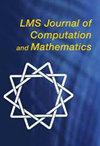Wieferich对和Barker序列,2
Q1 Mathematics
引用次数: 25
摘要
我们证明了如果存在一个长度为$n>13$的Barker序列,则n $=$ 3 979 201 339 721 749 133 016 171 583 224 100,或$n> 4\cdot 10^{33}$。这将长Barker序列长度的下界提高了近2000美元。我们还得到了18个不能排除作为Barker序列长度的额外整数$n<10^{50}$,并发现了超过237 000个额外候选$n<10^{100}$。这些结果是通过完成对Wieferich素数对的广泛搜索并使用它们以及对$n$的一些算术限制来构造低于给定界的合格整数而获得的。我们还报道了一些关于循环Hadamard矩阵问题的开放情况的更新计算。本文章由计算机程序翻译,如有差异,请以英文原文为准。
Wieferich pairs and Barker sequences, II
We show that if a Barker sequence of length $n>13$
exists, then either n $=$
3 979 201 339 721 749 133 016 171 583 224 100, or $n > 4\cdot 10^{33}$
. This improves the lower bound on the length of a long Barker sequence by a factor of nearly $2000$
. We also obtain eighteen additional integers $n<10^{50}$
that cannot be ruled out as the length of a Barker sequence, and find more than 237 000 additional candidates $n<10^{100}$
. These results are obtained by completing extensive searches for Wieferich prime pairs and using them, together with a number of arithmetic restrictions on $n$
, to construct qualifying integers below a given bound. We also report on some updated computations regarding open cases of the circulant Hadamard matrix problem.
求助全文
通过发布文献求助,成功后即可免费获取论文全文。
去求助
来源期刊

Lms Journal of Computation and Mathematics
MATHEMATICS, APPLIED-MATHEMATICS
CiteScore
2.60
自引率
0.00%
发文量
0
审稿时长
>12 weeks
期刊介绍:
LMS Journal of Computation and Mathematics has ceased publication. Its final volume is Volume 20 (2017). LMS Journal of Computation and Mathematics is an electronic-only resource that comprises papers on the computational aspects of mathematics, mathematical aspects of computation, and papers in mathematics which benefit from having been published electronically. The journal is refereed to the same high standard as the established LMS journals, and carries a commitment from the LMS to keep it archived into the indefinite future. Access is free until further notice.
 求助内容:
求助内容: 应助结果提醒方式:
应助结果提醒方式:


